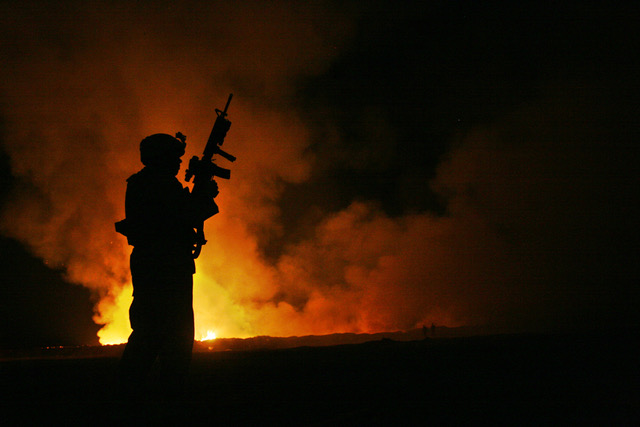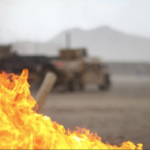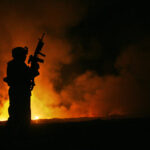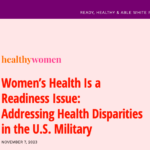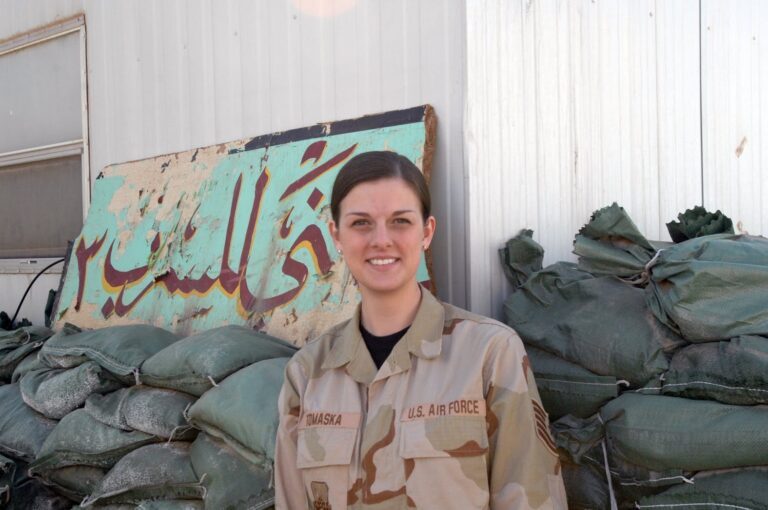Julie Tomaska remembers getting sick almost immediately after deploying to Balad Air Base, Iraq, for the first time in 2005: She had a dry cough that most newcomers to the base shared.
“They’d call it the ‘Iraqi Crud,’” Tomaska, who worked in communications and intelligence for the Air National Guard, said.
While leaders, she said, would say the cough was from the dust storms that frequently rolled across the base, another toxic cause was close by: the massive pits where the military burned trash, including medical waste, plastics and styrofoam, around the clock. When the flames got low, maintainers would pour jet fuel on the pits to restart the burn. Tomaska passed the pits multiple times a day, moving from the tents she slept in to the flight lines she worked on.
After two deployments to Balad, Tomaska found herself with a growing number of chronic symptoms, including severe headaches, shortness of breath and a dangerously racing heart rate. It wasn’t until 2018, more than a decade after her last deployment and after seeing a variety of doctors within the VA and in civilian practice, that she got a lung biopsy. A frightening series of diagnoses followed: emphysema, pleural fibrosis, chronic pleuritis and constrictive bronchiolitis (popcorn lung) — all chronic lung diseases.
“Most shocking to me was that they found visible soot on the outside of my lungs,” Tomaska says.
Tomaska is part of a massive number of veterans exposed to burn pits in Iraq and Afghanistan who now report chronic respiratory symptoms. While the full count of veterans who have developed chronic lung disease after working near burn pits is not known, new research indicates that the impact is widespread.
A 2023 survey showed veterans deployed to Iraq and Afghanistan reported new-onset asthma rates of up to 14%, compared to 8% in the general population. And a 2022 examination of 21 previously healthy veterans with burn pit exposure showed that all 21 had significantly decreased maximum expiratory pressure (MEP) values, which indicates that their lungs weren’t working as well as they should.
Tomaska also experienced the additional hurdle that female service members often have in seeking help: Despite a medical background that now includes a Ph.D. in public health, she struggled to convince her medical providers that her symptoms were real.
“I feel like a lot [of providers say], Oh, you’ve got kids and you’re tired. Oh, you’re probably pre-menopausal, or you’re postmenopausal. Or all these different things that they just kind of bucket for women,” she said. “Or they think we’re exaggerating, when really I think women tend to underreport things.”
Now the chair of the scientific advisory board for the veterans advocacy organization Burn Pits 360, Tomaska is part of the group’s effort to develop a larger pool of data to understand the correlation between burn pit exposure and chronic lung diseases.
Of more than 8,000 registrants in Burn Pits 360’s independent and self-reported veteran registry, a majority, she said, report at least one lung condition. Of the 540 registrants self-identified as female (more than half of registrants don’t have a gender listed), Tomaska says, 7 out of 10 report a lung condition. Of those, almost 6 in 10 report more than one lung condition.
The VA has maintained its own Airborne Hazards and Open Burn Pit Registry since 2014, with more than 336,000 registrants to date. About 9 out of 10 of those registrants report burn pit exposure. The most recent analysis of the registry, from 2022, shows that 1 in 10 registrants are female. While the analysis shows that about 12% of registrants report chronic bronchitis, it does not break down the prevalence of symptoms or conditions by gender. (The rate of chronic bronchitis among civilians is 3.1%.)
Historically, veterans have faced many difficulties in getting burn pit-related lung conditions recognized and covered by the VA. Chronic respiratory diseases, such as constrictive bronchiolitis, asthma and pulmonary fibrosis were finally recognized as being linked to burn pit exposure with the passage of the PACT Act of 2022. The act gave veterans healthcare benefits for exposure to burn pits, among other toxins. While that law represented a major victory for veterans, gaps remain. Burn Pits 360 notes the VA still lacks a dedicated diagnosis code for respiratory disorders related to deployment and an established screening protocol for assessing patients who come in with shortness of breath.
Tomaska said she’s working to bridge the gaps in what’s known about the correlation between burn pits and chronic lung disease for female service members. She does this through promoting proactive screening and diagnostics pathways. In May, Burn Pits 360 attended the American Thoracic Society annual conference alongside lung imaging company 4D Medical to promote non-invasive screenings. Tomaska said she’d like to see a more established protocol in which acknowledgement of burn pit exposures prompts a proactive screening, much like women past a certain age are offered routine mammograms.
For female veterans who have burn pit exposure and are seeking answers or help, Tomaska recommended they enroll in both registries: the VA’s and Burn Pits 360’s. They should also complete the initial screening process for lung conditions with the VA and work to get any symptoms recorded in their medical record. If they suspect something’s wrong, they should reach out to their medical providers or OB-GYN right away to begin the diagnosis and treatment conversation.
In light of her own struggle to be believed and get the answers she needed, Tomaska said she believes women need to be especially proactive about documenting their medical history and physician visits.
“I would just tell [these female service members] that they need to start being their own advocate for their health,” she says, “Because, unfortunately, it’s an uphill battle.”
Resources
Burn Pits 360 Burn Pits Registry
VA Airborne Hazards and Open Burn Pit Registry
The appearance of U.S. Department of Defense (DoD) visual information does not imply or constitute DoD endorsement.
This educational resource was created with support from AstraZeneca.


